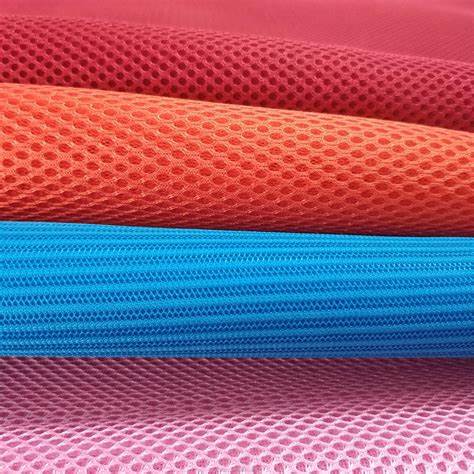Discover everything you need to know about mesh fabric, including its types, properties, and applications. This ultimate guide is perfect for anyone interested in learning more about this versatile and breathable material.
Introduction
Mesh fabric is a versatile and breathable material that is used in a wide range of applications. It is made by interlocking fibers in a way that creates small holes or gaps, allowing air to circulate through the fabric. In this ultimate guide, we’ll explore the different types of mesh fabric, their properties, applications, and care instructions.
Types of Mesh Fabric
Knitted mesh fabric and woven mesh fabric are two different types of mesh fabrics, each with its own unique properties and characteristics.
Knitted mesh fabric is created by interlocking loops of yarn or thread, similar to traditional knitted fabrics. This process results in a fabric that is soft, flexible, and stretchy. Knitted mesh fabric is often used in clothing and textiles where comfort and flexibility are important, such as in sportswear, activewear, and lingerie.
Woven mesh fabric, on the other hand, is created by interlacing two or more sets of fibers at right angles. This process results in a fabric that is stronger and more stable than knitted mesh fabric. Woven mesh fabric is often used in applications where durability and stability are important, such as in industrial and transportation applications, as well as in sportswear and outdoor gear.
In summary, knitted mesh fabric is softer and more flexible, while woven mesh fabric is stronger and more stable. Both types of mesh fabric have their own unique properties and are used in different applications depending on their specific characteristics.
Properties of Mesh Fabric
One of the key properties of mesh fabric is its breathability, which makes it an ideal choice for clothing and other applications where air circulation is important. Mesh fabric is also durable, and can withstand repeated wear and washing without losing its shape or texture. Depending on the fibers used to make the fabric, it can also have a range of textures, from smooth and silky to rough and textured. Additionally, mesh fabric can be stretchy, which allows it to conform to the shape of the wearer’s body.
Applications of Mesh Fabric
Mesh fabric is a versatile material that is used in a wide range of applications, including:
- Fashion: Mesh fabric is used to create lightweight, breathable clothing such as t-shirts, tank tops, and athletic wear. It is also used in sports equipment such as soccer jerseys, basketball shorts, and running shoes.
- Home Decor: Mesh fabric is used for curtains, tablecloths, and upholstery in home decor. It adds a unique texture and aesthetic to any room.
- Industrial: Mesh fabric is used for filtration, ventilation, and as a reinforcement material in composite materials in the industrial sector. It is also used in the manufacturing of various industrial products.
- Sports: Mesh fabric is used in sports equipment such as cycling jerseys, basketball jerseys, and soccer jerseys. It provides ventilation and breathability, keeping athletes cool and dry during competition.
- Medical: Mesh fabric is used in medical applications such as wound dressings, implantable devices, and surgical meshes. It provides a breathable and flexible material that can be used in various medical applications.
- Transportation: Mesh fabric is used in transportation applications such as seat covers, air filters, and fuel filters. It provides a lightweight and breathable material that can withstand high temperatures and harsh environments.
- Architecture: Mesh fabric is used in architectural applications such as facades, roofing, and interior design. It provides a unique aesthetic and can be used to create complex shapes and designs.
- Environmental: Mesh fabric is used in environmental applications such as water filtration, soil remediation, and erosion control. It provides a durable and flexible material that can withstand harsh environments.
- Military: Mesh fabric is used in military applications such as body armor, protective gear, and uniforms. It provides a lightweight and breathable material that can withstand high temperatures and harsh environments.
- Aerospace: Mesh fabric is used in aerospace applications such as space suits, satellite components, and aircraft interiors. It provides a lightweight and breathable material that can withstand extreme temperatures and harsh environments.
In summary, mesh fabric is a versatile material that is used in a wide range of applications, from fashion and home decor to industrial, sports, medical, transportation, architecture, environmental, military, and aerospace applications. Its unique properties make it an ideal material for various uses.

How to Care for Mesh Fabric
To keep your mesh fabric looking and feeling its best, it’s important to follow the proper care instructions. This typically involves washing the fabric in cold water, using a gentle detergent, and avoiding harsh chemicals or bleach. Mesh fabric should be air-dried, as high heat can damage the fibers and cause the fabric to shrink or lose its shape. Additionally, it’s important to avoid ironing mesh fabric, as this can cause the holes to close up and reduce the fabric’s breathability.
Conclusion
Mesh fabric is a versatile and breathable material that is used in a wide range of applications. Whether you’re looking for a lightweight and breathable fabric for your next workout outfit or a sturdy material for industrial filtration, mesh fabric has something to offer. By understanding the different types of mesh fabric, their properties, and their care instructions, you can ensure that your mesh fabric products last for years to come.



